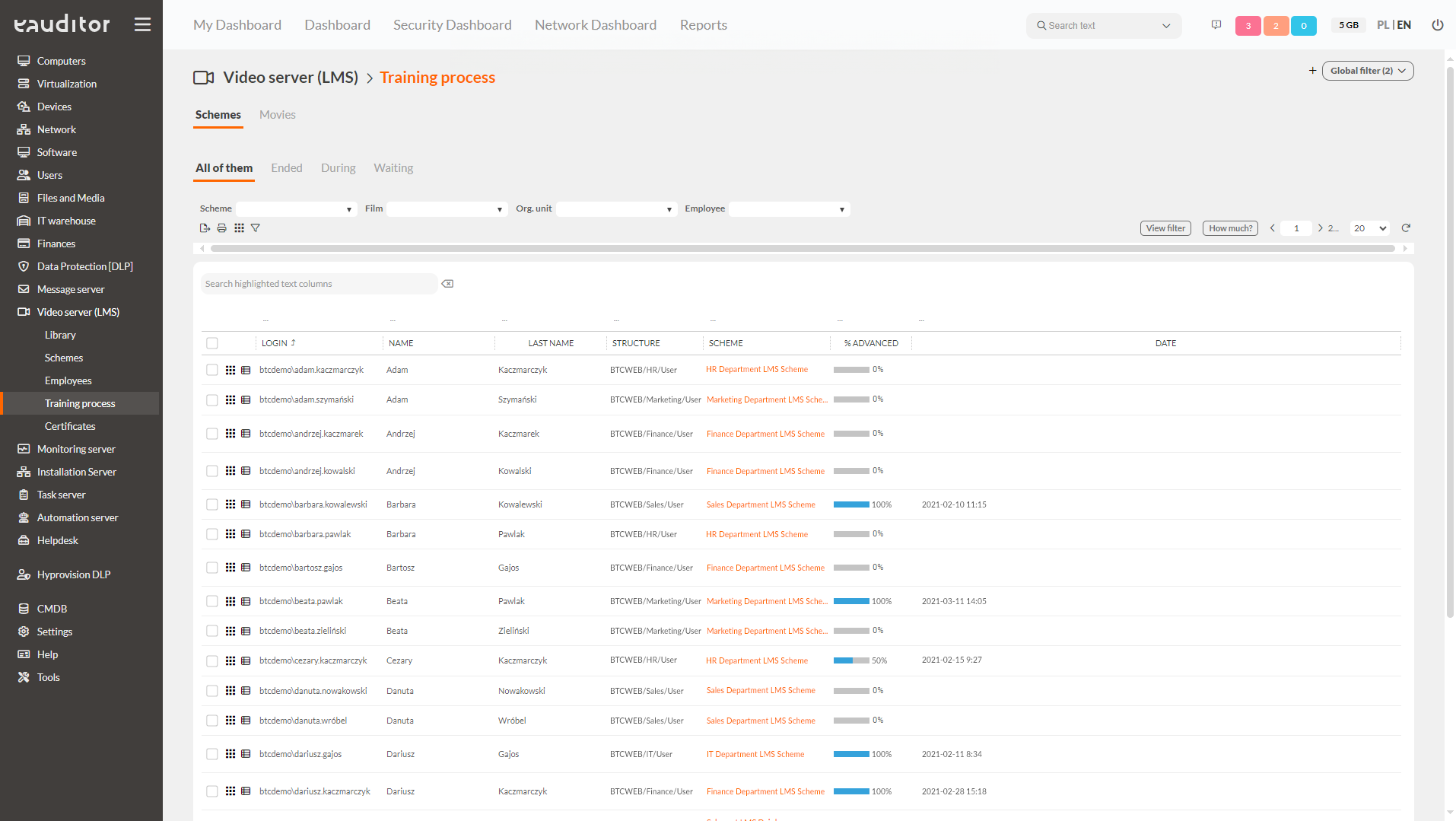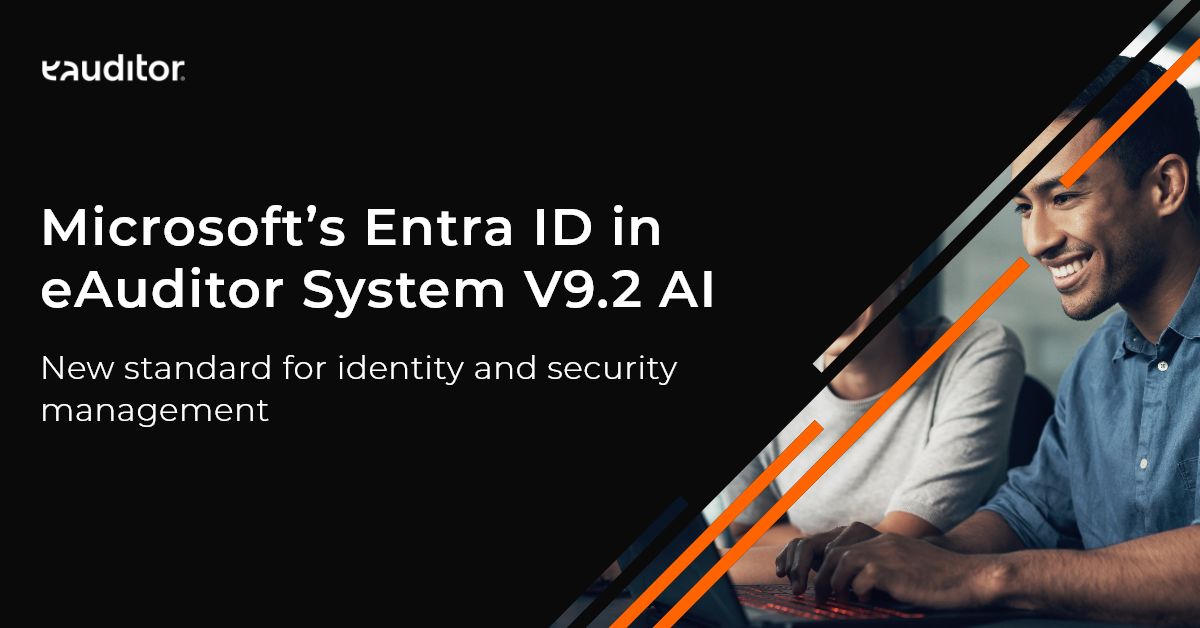How to implement an LMS in an organization?
Find out why you should use an employee training system (LMS)
Table of contents
1. What is an LMS – Learning Management System?
2. Who is the LMS designed for?
3. What are the advantages of implementing an LMS platform?
4. Why integrate an LMS with an IT infrastructure management system?
5. What does the implementation of the LMS look like in the eAuditor system?
What is an LMS – Learning Management System?
It is an advanced system for managing training in an organization, which provides each user with access to various learning sources. These can include dedicated videos posted in the library, but also training materials in the form of pdfs, audio recordings, regulations or knowledge tests, depending on the needs or strategy of the company. Literally translated, LMS from English means learning management system. Some LMS programs also allow certificates to be issued to participants upon completion of a course or exam. These certificates can often be freely modified and customized to suit your company’s style. It’s a resource for an organization to increase the level of individual skills and competencies of individual employees. It allows you to create, manage and deliver training materials to specific users through an online platform. LMS systems usually consist of two parts:
- user panel – from here the employee has access to all the training courses dedicated to him. He can use the prepared materials with information about their progress,
- administrator panel – the administrator can create, manage and organize training materials dedicated to specific employees in the organization. He also has the ability to monitor the progress of training, and the ability to set the cyclicity of training sessions at specific time intervals.
Who is the LMS designed for?
The LMS training system is now a very common platform for training management in many companies, regardless of the industry and size of the company. In addition to educational institutions such as schools and universities, the system is also used by companies for which the competence development of employees is of particular importance. These can be small, medium and large organizations – from microenterprises to multinational corporations. In both of these cases, employee training is an integral part of their operations. Large companies are constantly training thousands of employees from different departments. To facilitate this process, many of them are just using dedicated training platforms. This allows them to quickly assign specific training to employees in connection with, for example, a sudden change in regulations in a law they need to assimilate. Small organizations also train their employees through online platforms mainly to improve their competencies and skills. In this way, they influence the process of scaling the company’s growth, adapting to market changes.
What are the advantages of implementing an LMS platform?
Using an LMS employee training system has many benefits for both organizations and individual users. Below, we have included a comprehensive summary indicating the key advantages of implementing an LMS platform for each party in the process.
| For organizations | For the user |
|---|---|
| Reduce employee training costs | Easy access to dedicated training anywhere, anytime |
| Reduce employee training time | Flexible pace of learning |
| Ability to create individual learning paths for specific employee | Unlimited access to training materials |
| Facilitate the work of Project Managers and HR departments | Staying abreast of all industry/professional developments |
| Ability to monitor the progress of employee training | Independent, individual learning style |
| Ability to add your own training according to your company’s needs |
Improved productivity |
| Easier and simpler onboarding of employees |
Why integrate an LMS with an IT infrastructure management system?
Integrating an LMS with IT infrastructure management software is a great convenience for an organization. First of all, the implementation of an LMS employee training system is much simpler mainly because of the already structured IT environment. All organizational structures have already been defined within the IT management system, making it much easier to assign individual employees to dedicated training. There is no need to do this manually, as the process is done automatically. Such integration is a major simplification especially for organizations with extensive infrastructure. Moreover, by integrating the LMS employee training system with IT infrastructure management software, we gain not only easy and fast monitoring of training progress, but also many other benefits. Among these, the main ones affecting IT infrastructure security are increased employee productivity, data protection and control of the IT environment.
What does the implementation of the LMS look like in the eAuditor system?
Employee training management system (LMS) is one of the functionalities of the eAuditor system for managing IT infrastructure and security. The key features of this function are full automation, simplicity of use and the ability to upload customized training dedicated to employees. BTC Sp. z o.o., as an independent LMS provider, allows simple implementation of the system, which involves assigning the appropriate collection of videos (so-called schemas) to individual employees. This can be done manually, which, however, generates much more time, but also by assigning to existing organizational structures. The latter way is much faster, by providing full automation of training assignment. However, the eAuditor system offers full flexibility in this regard, depending on the needs of the organization. In addition, each scheme can be assigned to multiple employees. The system also allows you to assign videos to specific departments within your organization (marketing, sales or technical support). With this functionality, IT administrators can specify a set of specific trainings to a department, without having to individually identify each of the employees included in the department. Below we have prepared a summary with the benefits of implementing the LMS into eAuditor software.
Why use eAuditor’s employee training system (LMS)?
- automation of the training process by employees,
- cyclic repetition of training according to the indicated time interval,
- automatically generated certificates,
- assignment of training to specific employees or departments according to defined schemes,
- easy and fast monitoring of training progress,
- protection against fraudulent termination of training by rewinding the video.





